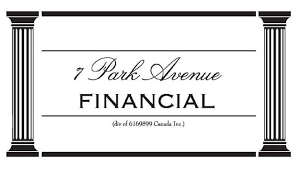|
Boost Your Cash Flow with Smart Inventory and Receivables Strategies
Transform Your Business Operations with Smart Financing Options
YOUR COMPANY IS LOOKING FOR CANADIAN ASSET BASED FINANCING BUSINESS LOAN CASH FLOW SOLUTIONS!
You've arrived at the right address! Welcome to 7 Park Avenue Financial
Financing & Cash flow are the biggest issues facing business today
ARE YOU UNAWARE OR DISSATISFIED WITH YOUR CURRENT BUSINESS FINANCING OPTIONS?
CALL NOW - DIRECT LINE - 416 319 5769 - Let's talk or arrange a meeting to discuss your needs
EMAIL - sprokop@7parkavenuefinancial.com

ACCOUNTS RECEIVABLE / INVENTORY FINANCING SOLUTIONS
"Accounts Receivable and Inventory Financing revolutionizes business liquidity by transforming sales and stock into immediate capital."
"Unlock your business's potential overnight with your existing sales and inventory!"
7 Park Avenue Financial originates business financing solutions for Canadian Businesses – We offer ACCOUNTS RECEIVABLE AND INVENTORY FINANCING solutions that solve the issue of cash flow and working capital – Save time, and focus on profits and business opportunities
INTRODUCTION
Asset-based financing is one of the newer terms business owners, and financial managers keep hearing about these days.
Growth in this area of asset-based loans has been driven by the tightening up of banks and traditional lenders in the SME COMMERCIAL FINANCE sector, who tend to focus on cash flow lending when it comes to commercial business financing needs for the right business loan and cash flow requirement.
Accounts Receivable and Inventory Financing is a key business funding strategy for companies to fund their current assets for growth and operations. Financing current assets allows businesses to convert their accounts receivable and inventory into immediate capital, offering a lifeline to companies needing cash flow without the traditional wait times associated with customer payments or the sale of goods.
Asset-based lending is when lenders grant loans based on the value of the collateral assets. Small, medium-sized, and large corporations can all access ABL solutions for greater credit availability.
The credit history of business owners has significantly less emphasis on asset-based funding. Lenders are flexible based on the face value of assets on the business's balance sheet. Unlike cash flow loans, facilities are based on ongoing sale revenues and asset values on the balance sheet.
The higher an asset's liquidity, the more a lender is willing to lend against it. An asset-based loan allows companies to borrow more than permitted for an unsecured loan and does not enforce financial ratios or covenants. Fixed assets are sometimes subject to appraisals as opposed to book value on a firm's financial statements. Interest rates are typically higher in asset-based lending than in traditional financial institutions that offer lower interest rates.
When times get tough owners/managers must look at all the alternatives available to their business regarding funding needs.
UNLOCKING SIGNIFICANT CASH FLOW POTENTIAL IN YOUR BUSINESS
When times get stricter businesses of all sizes look to alternatives in their overall financing strategy around the company's assets and sales to borrow money. The acronym for this form of finance is known by industry insiders as ' ABL ', as offered by 'asset based lenders', unlike a bank ' cash flow loan'.
So, who exactly provides this financing? Typically, it's non-bank commercial finance companies, which are independent and unregulated relative to banks and insurance companies—who no doubt find themselves extremely regulated when it comes to banks and unsecured loans—given that non-bank lenders don't take deposits and can take on more risk on collateral assets. Firms in the industry are a combo of Canadian, American, and even international.
The challenge? Sourcing the right facility that meets your needs and ensuring you have the right advice and expertise to make those funding decisions.
ABL LOANS VERSUS CASH FLOW BASED LOANS
The most fundamental definition of asset-based financing in the context of our information here is simply the provision of working capital and cash flow for your receivables, inventories, and, in many cases, physical assets such as equipment and real estate if applicable. In some cases, a term loan structure might make more sense.
The ability to successfully access receivable financing, inventory financing, and equipment funding makes or breaks a business's financial success. Doing that properly avoids 'cash flow problems'—both short-term and long-term.
As a result, sales financing via Receivables and inventory finance tends to dominate most of this type of financing. Many firms have problems with 'growth finance'—and most business folks quickly learn that sales and paper profits don't pay bills! A specific asset, such as real estate, can also be financed separately under various flexible terms.
Asset-based lines of credit are generally available to all medium- and large-size companies in Canada. Typically, start-ups and tiny firms lack the bench strength in assets to warrant this type of financing.
Asset-based lending is simply maximizing the actual value of your assets without the same focus that a bank might place on your overall financial statement quality. The facility generally has a limit, similar to a bank, but the reality is that as your assets grow, your ABL facility will increase too.
When clients ask what it takes to qualify for such a facility, we simply advise that their business must be viable overall. Quite often, ABL facilities can be uniquely structured to their specific industry and business model.
WHAT ARE THE BENEFITS OF A/R AND INVENTORY FINANCING?
The benefits of asset-based credit facilities are very significant - they include:
Improved cash flow and greater working capital
Shorter approval times to get the facility set up
Reporting is more stringent in asset-based lending because it focuses on the assets, but many clients tell us this additional reporting helps them understand their business better.
Higher financing costs in asset-based lending bring a higher cost of borrowing. Still, a considerable portion of these additional financing costs can be offset by better purchasing, taking advantage of supplier payment discounts, etc.. In some unique cases, we have seen the entire cost of an asset based financing facility being nicely absorbed by those two scenarios alone!
OTHER SUBSETS OF ASSET-BASED FINANCE SOLUTIONS
There are numerous 'subsets' of asset-based financing / secured loan finance that can quickly fix any cash flow or sales finance challenge.
They include:
Accounts Receivable Factoring / Financing
Confidential Accounts Receivables Financing
Inventory Loan
Permanent cash term loans
Merchant advances/Short Term Working Capital Loans
SR&ED bridge loans
Royalty based financing
Sale Leasebacks
In summary, the overall benefit of an asset-based financing or lending facility is simply access to greater cash flow and working capital based on a more generous loan-to-value ratio for assets compared with traditional financing institutions. There is no ' maximum loan amount ' in ABL. It is an alternative form of financing that, quite frankly, is developing into a traditional method of funding in Canada.
Asset-based facilities vary in size, structure, and rates based on your firm's overall financial position. Your firm may well be experiencing some financial challenges, but that does not preclude you from getting this type of financing.
KEY TAKEAWAYS
- Asset-Based Lending and Cash Flow Management provide deep insights into Accounts Receivable and Inventory Financing.
- These strategies allow businesses to obtain loans using receivables and inventory as collateral, converting these assets into working capital.
- Collateral Valuation is essential in determining the borrowable capital amount.
- Optimizing working capital improves operational efficiency by allocating funds for essential expenses, thereby preserving liquidity.
- The significance of Credit Risk Assessment ensures businesses using these financial solutions uphold a favourable credit rating, facilitating future access to necessary funds.
CONCLUSION
It’s all about the 'asset '. Call 7 Park Avenue Financial, a trusted, credible and experienced Canadian business financing advisor to determine what benefits an ABL facility will bring to your Canadian business and its growth opportunities. Asset-based lending provides customized business loans or a line of credit for day-to-day short-term needs secured by accounts receivable, inventory, and fixed assets.
FAQ: FREQUENTLY ASKED QUESTIONS / MORE INFORMATION
What is Asset based lending ?
Asset-based lending is when lenders grant loans based on the value of the assets offered to them as collateral. Small, medium-sized, and large corporations can all access ABL solutions for greater credit availability.
The credit history of business owners has significantly less emphasis on asset-based funding. Lenders are flexible based on the face value of assets on the business's balance sheet. Unlike cash flow loans, facilities are based on ongoing sale revenues and asset values on the balance sheet.
The higher an asset's liquidity, the more a lender is willing to lend against it. An asset-based loan allows companies to borrow more than permitted for an unsecured loan and does not enforce financial ratios or covenants. Fixed assets are sometimes subject to appraisals instead of book value on a firm's financial statements. Interest rates are typically higher in asset-based lending than in traditional financial institutions that offer lower interest rates.
What are the benefits of Accounts Receivable Financing for my business?
It provides an immediate solution to improve cash flow from unpaid invoices, enhance liquidity, and enable you to meet operational needs swiftly and purchase inventory.
How does Inventory Financing benefit my company?
This allows you to leverage unsold stock as collateral for a loan, providing capital to replenish or expand inventory without depleting cash reserves.
Can these financing options impact my business credit score?
Responsibly managing these loans can positively affect your credit score by demonstrating creditworthiness through timely repayments. The accounts receivable balance will fluctuate as sales fluctuate
What types of businesses are best suited for Accounts Receivable and Inventory Financing?
Businesses with large receivables or inventory, such as manufacturing, wholesale, and distribution companies, benefit the most from receivable factoring and ABL lending for inventory.
Are there risks associated with Accounts Receivable Invoice Factoring and Inventory Financing?
Like all financial strategies, risks include dependency on these loans for cash flow and potential collateral loss if loans are not repaid.
How do interest rates for these financing options compare to traditional loans?
Interest rates may be higher due to the higher risk to lenders, but rates vary based on creditworthiness and the value of your receivables or inventory.
Is personal collateral required for Accounts Receivable and Inventory Financing?
Typically, the outstanding invoices represented by receivables on the balance sheet or inventory serve as collateral, reducing the need for personal assets as security.
What happens if customers do not pay the receivables used for financing?
The financing company may require you to replace the unpaid receivables with new ones or settle the loan value in cash.
Can I use these financing options for long-term investments?
They are generally used for short-term liquidity needs. Long-term investments might require different financing solutions.
How quickly can I access funds through Accounts Receivable and Inventory Financing?
Funds can often be accessed within a few days of approval, making it a fast option for urgent liquidity needs.
How is the borrowing amount determined in Accounts Receivable and Inventory Financing?
Lenders evaluate the market value of your receivables and inventory, typically offering a percentage as the loan amount based on their assessed risk and liquidity.
What is the typical duration for these types of loans?
These loans are usually short-term, ranging from 3 to 12 months, designed to meet immediate working capital needs.
Can I use both Accounts Receivable and Inventory Financing simultaneously?
Yes, businesses can leverage both financing options simultaneously, maximizing liquidity by using sales and inventory as collateral.

' Canadian Business Financing With The Intelligent Use Of Experience '
STAN PROKOP
7 Park Avenue Financial/Copyright/2025

ABOUT THE AUTHOR: Stan Prokop is the founder of 7 Park Avenue Financial and a recognized expert on Canadian Business Financing. Since 2004 Stan has helped hundreds of small, medium and large organizations achieve the financing they need to survive and grow. He has decades of credit and lending experience working for firms such as Hewlett Packard / Cable & Wireless / Ashland Oil
|